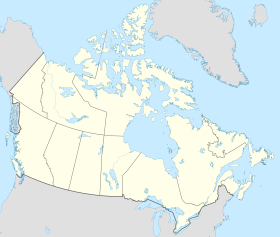
Back Yukon Afrikaans ዩካን Amharic Geocon ANG يوكون (إقليم) Arabic ܝܘܩܘܢ ARC Yukón AST Yukon Azerbaijani یوکان AZB Yukon BAN Yukon (Territorium) BAR
Yukon
| |
|---|---|
| Coordinates: 63°00′00″N 135°00′00″W / 63.00000°N 135.00000°W | |
| Country | Canada |
| Confederation | June 13, 1898 (9th) |
| Capital | Whitehorse |
| Largest city | Whitehorse |
| Largest metro | Whitehorse |
| Government | |
| • Commissioner | Angélique Bernard |
| • Premier | Sandy Silver (Liberal) |
| Legislature | Yukon Legislative Assembly |
| Federal representation | Parliament of Canada |
| House seats | 1 of 338 (0.3%) |
| Senate seats | 1 of 105 (1%) |
| Area | |
| • Total | 482,443 km2 (186,272 sq mi) |
| • Land | 474,391 km2 (183,163 sq mi) |
| • Water | 8,052 km2 (3,109 sq mi) 1.7% |
| • Rank | Ranked 9th |
| 4.8% of Canada | |
| Population (2016) | |
| • Total | 35,874 [1] |
| • Estimate (2020 Q4) | 42,176 [2] |
| • Rank | Ranked 13th |
| • Density | 0.08/km2 (0.2/sq mi) |
| Demonyms | Yukoner FR: Yukonnais(e) |
| Official languages |
|
| GDP | |
| • Rank | 13th |
| • Total (2017) | C$3.089 billion[4] |
| • Per capita | C$75,141 (3rd) |
| HDI | |
| • HDI (2018) | 0.908[5] — Very high (5th) |
| Time zone | UTC−07:00 |
| Postal abbr. | YT |
| Postal code prefix | |
| ISO 3166 code | CA-YT |
| Flower | Fireweed |
| Tree | Subalpine fir[6] |
| Bird | Common raven |
| Rankings include all provinces and territories | |
The Yukon is a territory of Canada, north of British Columbia, west of the Northwest Territories, and east of the American state of Alaska. Its population is 31,000. Most of the territory's people live in the capital of Whitehorse. Many of the people are native Canadians (First Nations).
The Yukon became a territory in 1898. It was part of the Northwest Territories from 1870 to 1898. Many people came to live in the Yukon during the Yukon Gold Rush of the 1890s.
Mount Logan, at 5959 metres above sea level, is Canada's highest mountain.
The most important industry in the Yukon is mining.
- ↑ "Population and dwelling counts, for Canada, provinces and territories, 2016 and 2011 censuses". Statistics Canada. February 2, 2017. Retrieved April 30, 2017.
- ↑ "Population by year of Canada of Canada and territories". Statistics Canada. September 26, 2014. Retrieved September 29, 2018.
- ↑ "The Legal Context of Canada's Official Languages". University of Ottawa. Archived from the original on December 21, 2016. Retrieved October 7, 2016.
- ↑ "Gross domestic product, expenditure-based, by province and territory (2017)". Statistics Canada. September 22, 2019. Retrieved September 22, 2019.
- ↑ "Sub-national HDI - Subnational HDI - Global Data Lab". globaldatalab.org. Retrieved 2020-06-18.
- ↑ "Government of Yukon: Emblems and Symbols". Archived from the original on February 12, 2012.

